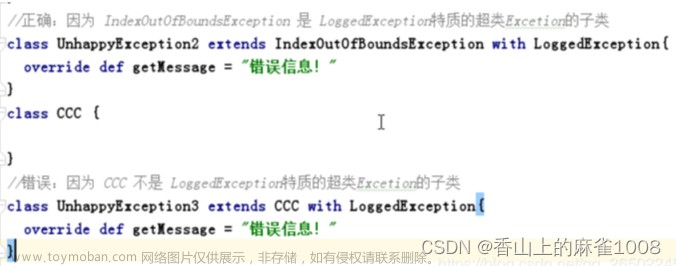1. 默认参数值
1.1 方法默认参数
def main(args: Array[String]): Unit = {
//定义打印日志方法
def log(date:Date,msg:String,level:String="Info"): Unit ={
println(s"$date $level $msg")
}
log(new Date,"你好");
log(new Date(),"你好","Info");
log(new Date(),"错误信息","Error");
}
默认值顺序在中间的调用加上命名参数才能调用,否则报错
def log(date:Date,level:String="Info",msg:String): Unit ={
println(s"$date $level $msg")
}
log(new Date,msg="你好");
1.2 类默认参数
def main(args: Array[String]): Unit = {
val point1 = new Point(y = 1)
point1.printLocation()
}
class Point(val x: Double = 0, val y: Double = 0){
def printLocation(): Unit ={
print(s"x=$x $y")
}
}
2. 特质 (Traits)
用于在类 (Class)之间共享程序接口 (Interface)和字段 (Fields)。 它们类似于Java 8的接口。 类和对象 (Objects)可以扩展特质,但是特质不能被实例化,因此特质没有参数。
2.1 子类型
trait Animal {
def say(): Unit ={
println("animal say....")
}
def walk(): Unit ={
println("animal walk....")
}
}
//cat 继承animal
class Cat extends Animal{
def miaomiao(): Unit ={
println("car miaomiao...")
}
}
def main(args: Array[String]): Unit = {
val cat=new Cat()
cat.miaomiao()
cat.walk()
cat.say()
}
// car miaomiao...
//animal walk....
//animal say....
2.2 扩展特征,当做接口来使用
//定义迭代器 使用泛型T
trait Iterator[T] {
def hasNext: Boolean
def next(): T
}
//自定义实现的Int类型的迭代器
class IntIterator(to: Int) extends Iterator[Int] {
private var current = 0
override def hasNext: Boolean = current < to
override def next(): Int = {
if (hasNext) {
val t = current
current += 1
t
} else 0
}
}
def main(args: Array[String]): Unit = {
val intIterator = new IntIterator(5)
while(intIterator.hasNext){
println(intIterator.next())
}
// 0
// 1
// 2
// 3
// 4
3.元组
元组是一个可以包含不同类型元素的类,元组是不可变的。
经常用于函数返回多个值。
元组包含2-22给个元素之间。
3.1 定义与取值
def main(args: Array[String]): Unit = {
val t1 = Tuple1(1)
//访问元素
println(t1._1)
val t2 = new Tuple1("asdas")
println(t2._1)
//也可以直接括号
val t3=("as",12,false)
//指定类型
val t4=("as",12,true,0.88):Tuple4[String,Int,Boolean,Double]
}
3.2 元组用于模式匹配
def main(args: Array[String]): Unit = {
val courseScores = List(("Chinese", 77), ("Math", 100), ("Geo", 0 ),("English", 55 ))
//遍历
courseScores.foreach{ tuple => {
tuple match {
case p if(p._2 == 100) => println(s" ${p._1} score is 100")
case p if(p._2 > 60 ) => println(s" ${p._1} score is greater than 60")
case p if(p._2 == 0) => println(s" ${p._1} score is o")
case _ => println(s"不及格")
}
}
}
3.3 用于for循环
def main(args: Array[String]): Unit = {
val numPairs = List((2, 5), (3, -7), (20, 56))
for ((a, b) <- numPairs) {
println(a * b)
}
///10
//-21
//1120
}
4 高阶函数
使用函数来作为参数或则返回结果。
4.1 常见的高阶函数map
def main(args: Array[String]): Unit = {
var seqno = Seq(1,2,3)
val values = seqno.map(x => x * x)
for ( x <- values ){
println(x )
}
// 1
// 4
// 9
}
4.2 简化涨薪策略代码
//定义加薪的规则
def smallPromotion(salaries: List[Double]): List[Double] =
salaries.map(salary => salary * 1.2)
//薪资的
def greatPromotion(salaries: List[Double]): List[Double] =
salaries.map(salary => salary * math.log(salary))
//薪资
def hugePromotion(salaries: List[Double]): List[Double] =
salaries.map(salary => salary * salary)
}
去掉重复代码,定义一个方法接口,涨薪的规则传入函数
def promotion(salaries: List[Double], promotionFunction: Double => Double): List[Double] = {
salaries.map(promotionFunction)
}
测试
val salaries = List(2500.00,3000.00,4000.00)
//实现涨薪
var newsalaries= promotion(salaries,(x:Double) => x* 1.2)
for(s <- newsalaries){
print(s"$s ")
//3000.0 3600.0 4800.0
}
println()
println("-----------------------------")
println()
var newsalaries2= promotion(salaries,(x:Double) => x* x)
for(s <- newsalaries2){
print(s"$s ")
//6250000.0 9000000.0 1.6E7
}
5.嵌套方法
嵌套方法经常使用的就是递归调用。
求阶乘
//定义阶乘
def fac(x:Int):Int = {
if (x==1) {
x
}
else {
x * fac(x-1)
}
}
//24
print(fac(4))
6.多参数列表(柯里化)
方法可以定义多个参数列表,当使用较少的参数列表调用多参数列表的方法时,会产生一个新的函数,该函数接收剩余的参数列表作为其参数。这被称为
柯里化。
def foldLeft[B](z: B)(op: (B, A) => B): B = {
var acc = z
var these: LinearSeq[A] = coll
while (!these.isEmpty) {
acc = op(acc, these.head)
these = these.tail
}
acc
}
测试
val numbers = List(1, 2, 3, 4, 5, 6, 7, 8, 9, 10)
val res = numbers.foldLeft(0)((m, n) => m + n)
print(res) // 55
7.模式匹配
7.1 简单的模式匹配
def main(args: Array[String]): Unit = {
val x: Int = Random.nextInt(5)
val str = x match {
case 0 => "zero"
case 1 => "one"
case 2 => "two"
case _ => "other"
}
println(str)
}
8.隐式转换
方法可以具有 隐式 参数列表,由参数列表开头的 implicit 关键字标记。 如果参数列表中的参数没有像往常一样传递, Scala 将查看它是否可以获得正确类型的隐式值,如果可以,则自动传递。文章来源:https://www.toymoban.com/news/detail-461445.html
8.1 官网的列子
//定义一个抽象类,提供两个方法一个add 一个unit
abstract class Monoid[A] {
def add(x: A, y: A): A
def unit: A
}
//隐式实现字符串的拼接
implicit val stringMonoid: Monoid[String] = new Monoid[String] {
def add(x: String, y: String): String = x concat y
def unit: String = ""
}
//隐式实现整型的数字相加
implicit val intMonoid: Monoid[Int] = new Monoid[Int] {
def add(x: Int, y: Int): Int = x + y
def unit: Int = 0
}
//传入一个list实现不同类型的累加
def sum[A](xs: List[A])(
implicit m: Monoid[A]): A =
if (xs.isEmpty) m.unit
else m.add(xs.head, sum(xs.tail))
println(sum(List(1, 2, 3))) // 6
println(sum(List("a", "b", "c"))) //abc
完结,其他的可以到官网看看,用到在学。文章来源地址https://www.toymoban.com/news/detail-461445.html
到了这里,关于Scala的高级用法的文章就介绍完了。如果您还想了解更多内容,请在右上角搜索TOY模板网以前的文章或继续浏览下面的相关文章,希望大家以后多多支持TOY模板网!







